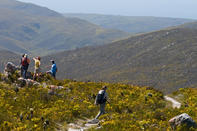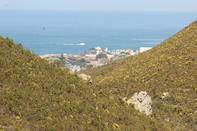Indigenous Vegetation
The protea family is well represented in the Potberg area: look out for ground species like Protea denticulata, which adds to the rich Overberg Biodiversity and Plant Life. The small deep-red, brown-tipped flowers are pollinated by rodents that feed on the seeds.

On the drier northern slopes of the Potberg mountains you will see more crassulas and aloes than on the moist, southern slopes, where thick fynbos predominates by virtue of the sea mists.
The De Hoopvlei in the De Hoop Nature Reserve is a rich source of primary foods (those at the beginning of the food chain), where phragmites (whistle) reeds, bulrushes and sedges line the shores, along with the water onions and various water grasses that provide food for the many water fowl. The only indigenous fish in the vlei is the Cape kurper (bream), while introduced tilapia from Malawi have also established themselves.
The coast of the reserve is mostly dominated by sand dunes. These dunes are part of a mobile belt of sea sand that circulates around the Overberg coast, and from which the country's famous beaches are fed after winter storm waves have eaten their fill. Coastal development, especially that of holiday townships, has stabilised much of these dune fields thus cutting off the natural supply of sand around our coast.
Few plants are able to survive the tenuous conditions here, but where moisture gathers in depressions, various hardy grasses and small shrubs such as the bitou, blombos, cancer bush and waxberry bushes do provide a splash of softening vegetation.
Nature Reserves

Die Mond is an interesting stop near Struisbaai. From the barely vegetated dunes, the western bank of the Heuningnesrivier Estuary, the shores are laced with milkwood trees (Sideroxylon inerme), bietou (Chrysanthemoides monilifera) and other bushes.
The Fernkloof Nature Reserve spans a wide gorge-like valley in the Kleinriviersberge, with Die Mond se Kop and Olifantsberg standing as sentinels to the gorge. The Aasvoélkop summit forms the northeastern corner of the reserve, to the east of which abutting the Fernkloof reserve lies the private Vogelgat Reserve.
The vegetation is typical of this coastal range's rich and dense fynbos, with 98 recorded species of bird, baboons, klipspringers and other small animals that are seldom seen.
 When headed to the Overberg, you’ll find a graveyard of ships and floral riches beyond compare along a coastline patrolled by great white ...
When headed to the Overberg, you’ll find a graveyard of ships and floral riches beyond compare along a coastline patrolled by great white ...